My photo below is an Arizona landscape just before sunset. It shows just how limiting photographs can be. The actual scene had very chromatic, yet delicate pinks and oranges in the sky and gorgeous warm and cool colors in the foreground brush. There were wonderful neutral grays setting off the colorful shadows. All of which are missing from the photo. On location I make notes about these subtle, yet wonderful colors. A color sketch is the ideal choice for information.
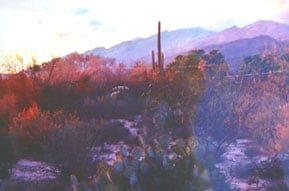
To start this painting, I organized my thoughts by doing a small sketch and then roughed in the shapes and designs. This established the composition that I wanted. I moved the cactus and mountains around a bit to make it a better composition. Don’t be a slave to the photo’s design – crop and re-design however you want.
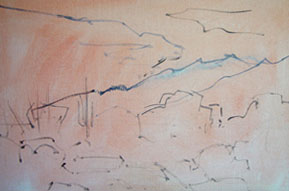
I began adding in the darks of the trees because they will act as anchors in the painting. Sap Green oil paint and touch of Alizarin Crimson worked nicely for the darks. The lighter side of the tree, which was also part of the dark shape, was Sap Green and Quinacridone Gold.
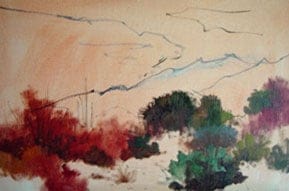
Next came the blocking in of the big dark shapes. Because I paint direct (color next to color), I do not paint the sky behind the tree and then add the tree over the sky. They must be separate shapes with hard and soft edges between.
My palette includes DANIEL SMITH Lemon Yellow, Cadmium Yellow, Pyrrol Scarlet, Alizarin Crimson, Quinacridone Rose, Quinacridone Gold, Quinacridone Burnt Orange, Ultramarine Blue Deep, Viridian and Titanium White. I like to keep my palette limited to ten colors.
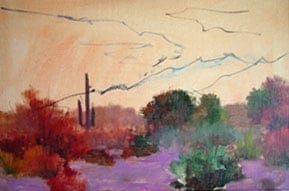
Blocking in the ground of the foreground needed careful thought about the values. The ground was a very light earth tone, but it was the lightest dark. The earth value needed to stay down on the scale to read correctly. For the distant mountains to recede, there needed to be another value jump – they needed to be more of the sky family than the earth family. The darks of the clouds were another value jump as well. They are still lighter than any value in the earth. Many beginners make the belly of the clouds much too dark.

Blocking in the painting, I covered the whole canvas before switching to a smaller brush. Only after I was satisfied that the values and color were in the right place, did I put in the detail. This was like putting the icing on the cake.
The painting was meant to convey that wonderful last light of the day. Shadow colors became muted, but they still kept their richness with a value range that lets you tell a cactus from a mesquite. A good exercise to train your eye is to take a photograph at sunset.
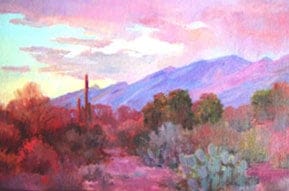
Return with the photo at the same time and notice how intense the colors of the real landscape are. Try and mix in your mind the wonderful grays that hold the scene together. Shadows are the building blocks of a painting. Make them rich!




